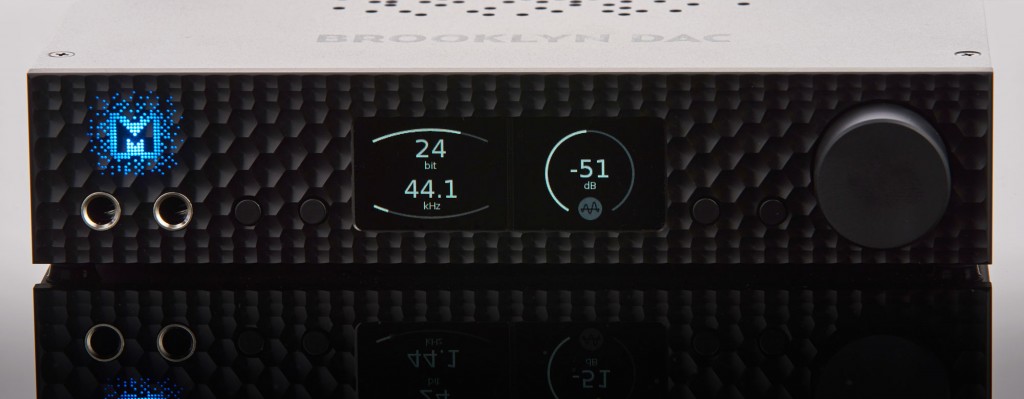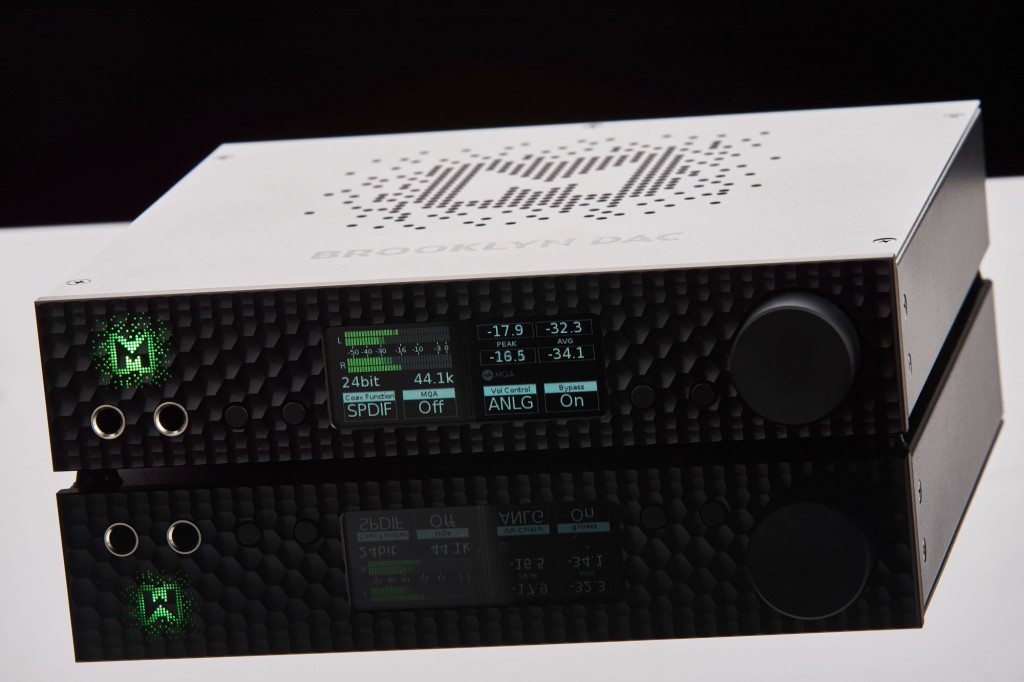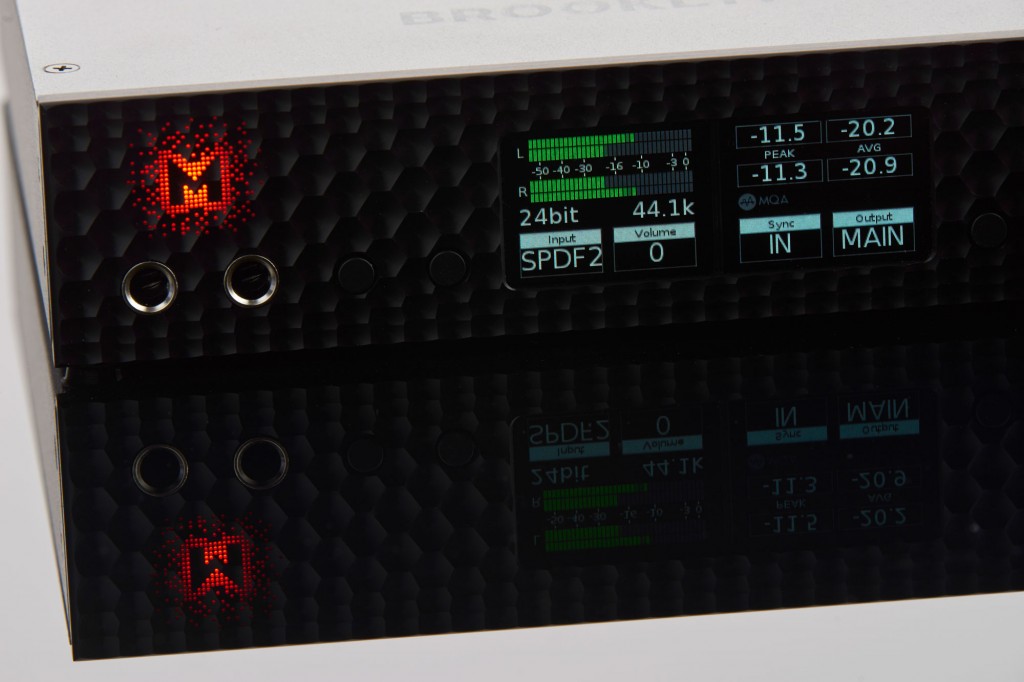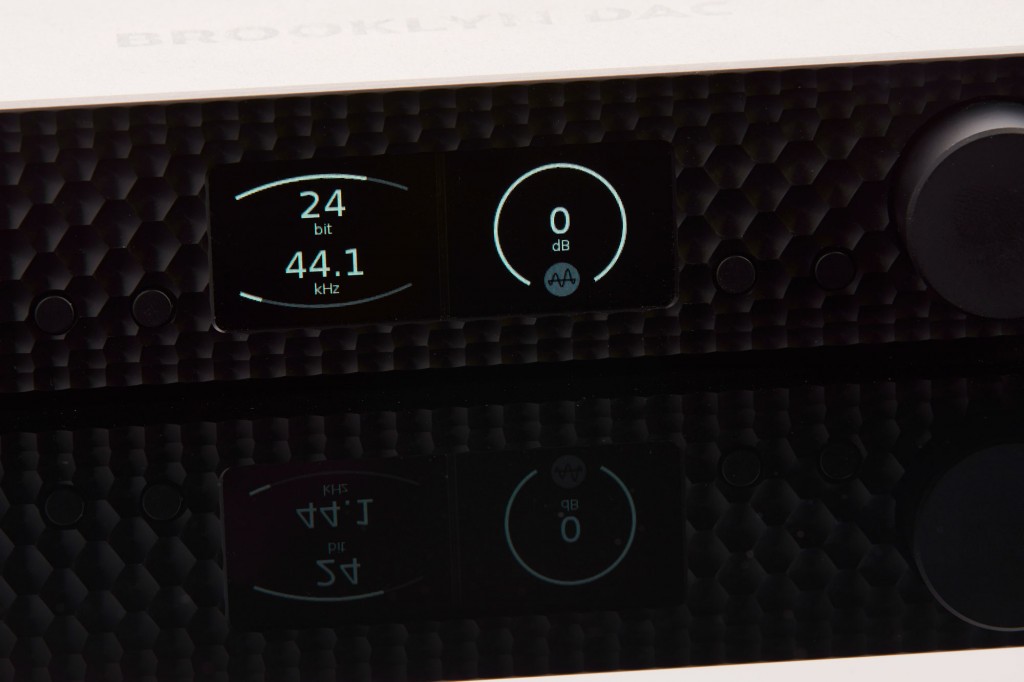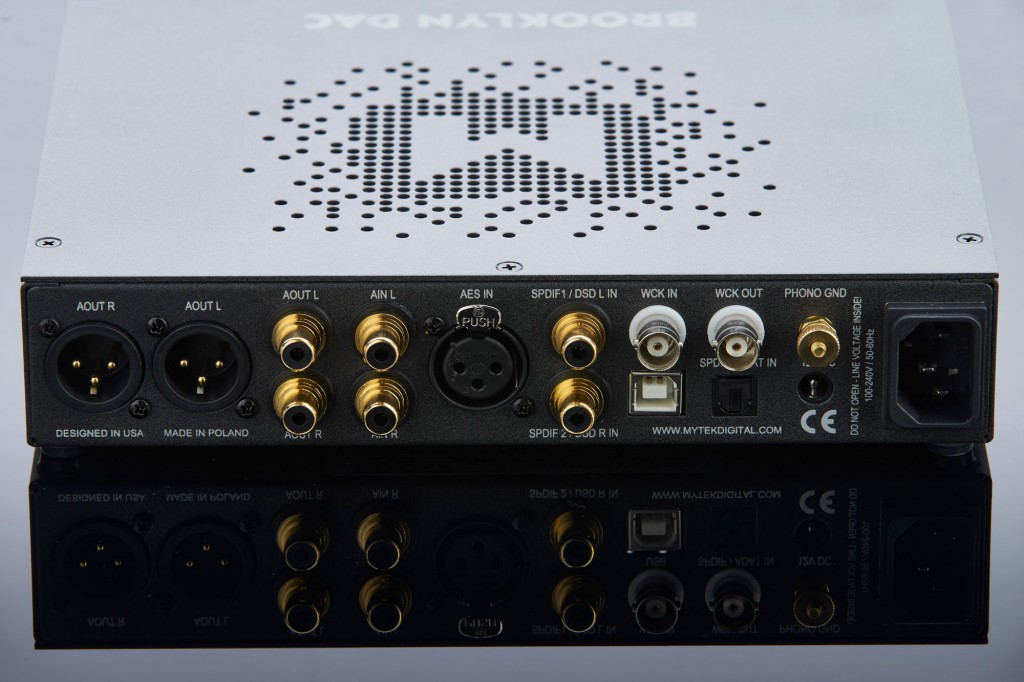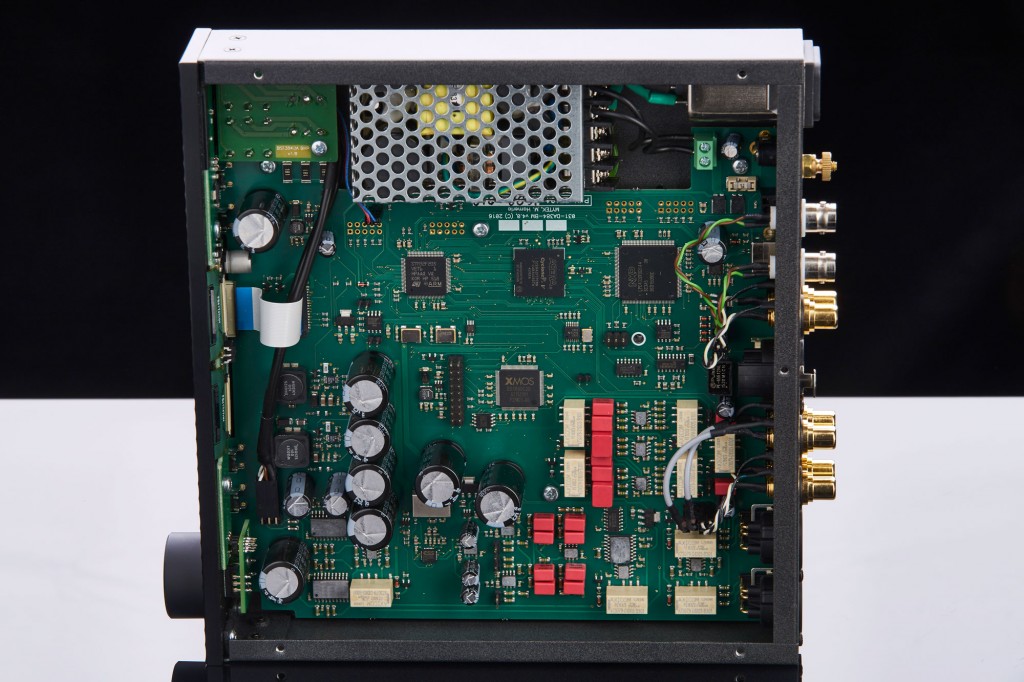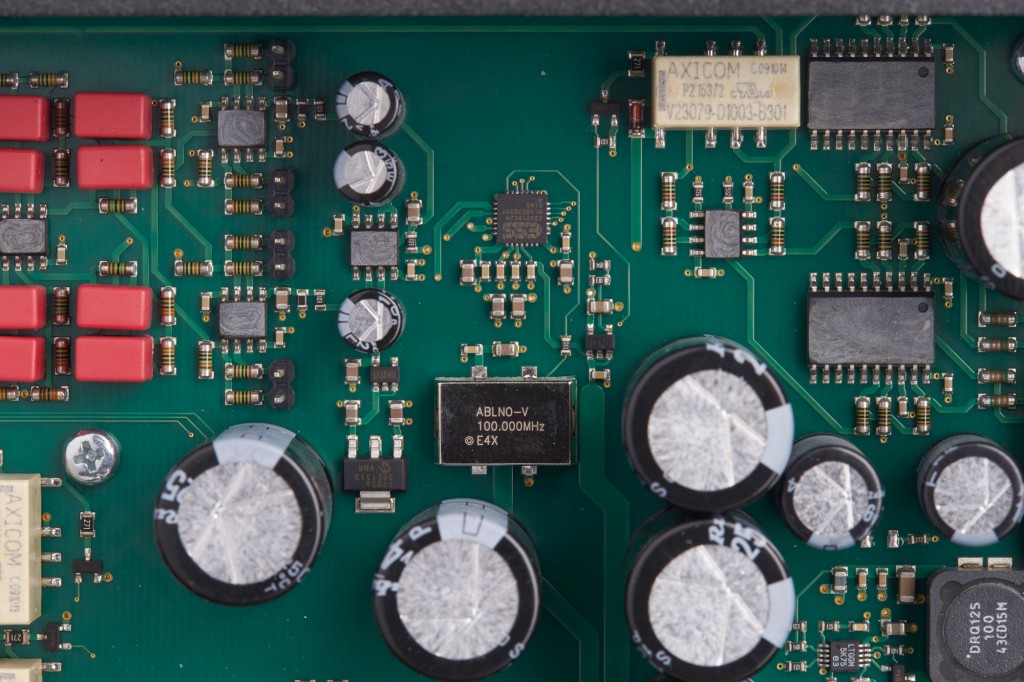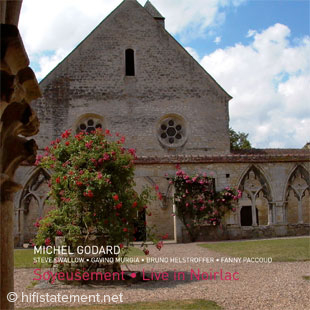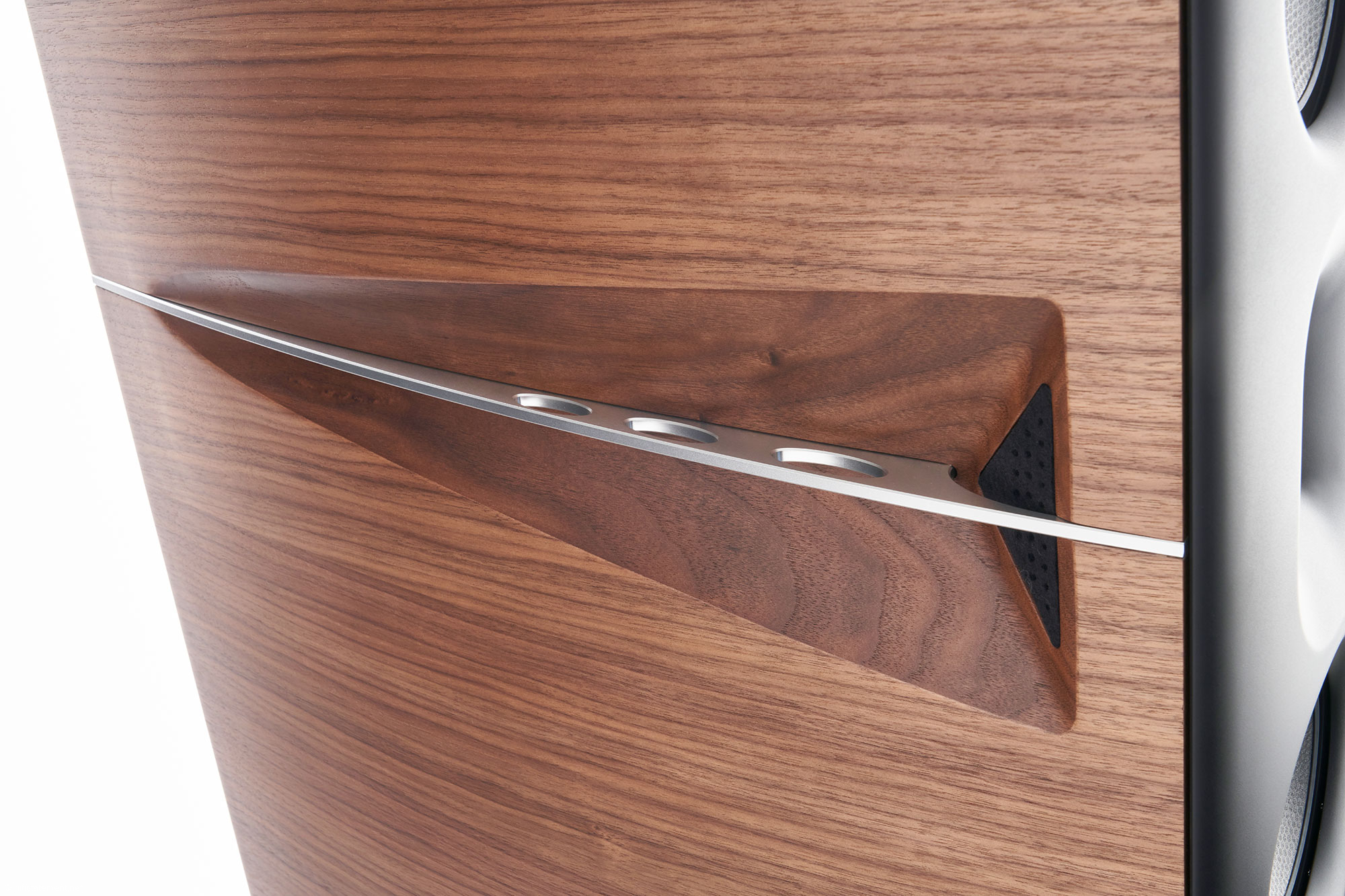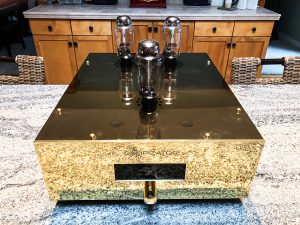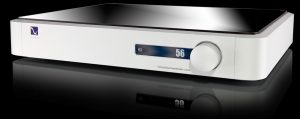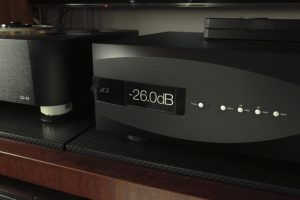About four years ago, the Mytek 192-DSD-DAC impressed me with its sound in a way that caused me to abstain from purchasing expensive D/A converters for quite a while. This is not bad at all in times of rapid new developments. After a venture into high-end territory, these digital experts with roots in the pro audio realm are now introducing the Mytek Brooklyn DSD DAC.
At first glance, this new converter seems to be the perfect synthesis of the plain looking 192-DSD-DAC which was designed primarily for studio use, but became very popular with the hi-fi crowd due to its almost unbeatable price-performance ratio in terms of sound, despite its slight weaknesses in menu navigation, and the Manhattan. This model, with its very individual chassis design, its large and easily readable display, and consequently a higher price tag was clearly aimed at a hi-fi/high-end clientele. The Brooklyn ($1995) inherited its top cover emblazoned with the company logo and the structured front panel from the Manhattan. However, the four push buttons do not have the same carefully milled surface that discreetly and inconspicuously made them integrate into the Manhattan's front surface. Instead, the Brooklyn sports an LED-lit Mytek logo in the left corner of the chassis, whose colours can be customised via the now incredibly easy-to-operate user menu. While the colour customisation is a nice gimmick, the new menu navigation eliminates the only real weakness of the previous model.
The two headphone jacks allow balanced connection of a pair of headphones via an adapter. The amplifier is capable of delivering up to six watts of output power.
In the Brooklyn's display, four user selectable parameters are shown, including their current value and a description such as "USB" or "Input". The parameter and its name appear on the left part of the display. When pressing the leftmost button on the front panel, the colour of the shown setting changes. The rotary knob can then be used to adjust it. Another push of the button ends the procedure. In this mode, turning the large black rotary encoder causes the next four menu items to be displayed, which can then be adjusted upon pressing the appropriate button on the front panel. The Brooklyn's menu offers access to 14 settings, including brightness and—as previously mentioned—the background colour of the Mytek logo. Thanks to the new, well thought-out menu navigation, you always know what you are doing. This is a major improvement over the Stereo 192-DSD-DAC!
But also in other areas, the Brooklyn has more to offer than its predecessor. In the menu, the analogue inputs can be configured for line, phono MM, and phono MC sources. In combination with its analogue volume control, this makes the Brooklyn a complete preamplifier. The only drawback is that you have to swap cables on the single pair of RCA inputs when switching between line and phono sources. There is simply no space left for a second or third pair on the back panel of the Mytek. With the Stereo 192-DSD-DAC you still had to choose between a mastering and a preamp version. The former offered a SDIF-3 input for DSD and a fairly coarse LED level meter, while the latter was equipped with a line-level analogue input. As previously mentioned, the Brooklyn offers an analogue input that is also suitable for phono sources as well as the SDIF-3 input. However, the lack of space on the rear panel makes it necessary to use the two S/PDIF RCA inputs for this. In the menu item "Coax Function" you can set either of the two RCA sockets to function as two S/PDIF or SDIF-3 for one of the two stereo channels. As always, the corresponding word clock input is present in the form of a BNC socket.
The success of the Stereo 192-DSD-DAC has given Mytek more self-consciousness. The top cover and the front panel are now emblazoned with the company logo; the one on the front has coloured back-lighting. The LED's shade can be determined by the user.
A second BNC socket allows the Brooklyn to act as master clock for other equipment. And this isn't the exactly a bad idea, since the Brooklyn has a Mytek Femto clock Generator™ with a claimed internal jitter of only 0.82 picoseconds in the direct vicinity of the ESS Sabre 9018K2M converter chip. The Stereo 192-DSD-DAC was still equipped with the Sabre 9016 chip. The 9018—according to its data sheet—has 3dB more dynamic range and 3dB less harmonic distortion. Contrary to the predecessor model, the user can no longer make changes to the signal processing within the chip. The Brooklyn neither supports different filters nor an up-sampling option. Marcin Hamerla explained to me via Skype that they simply followed the chip manufacturer's specifications in this respect, and also that he redesigned the analogue output section. When testing the 192-DSD-DAC at that time, its sound already automatically reminded me of the Wadia—whose output stage was described by its developer as a "sledgehammer" without exaggerating.
As already reported here in a company profile, Mytek's converters and professional monitoring systems are primarily designed by Michal Jurewicz in New York and Marcin Hamerla in Warsaw. Marcin is now being supported by four other engineers, and he also oversees manufacturing. In addition, he is responsible for the new switching power supply, which gives the Brooklyn the capacity to now supply up to six watts of output power through the redesigned headphone preamp as well. The two headphone sockets underneath the Mytek logo provide an in-phase and a phase-reversed signal, making balanced headphone operation possible with a special adapter or cable (that unfortunately isn't supplied with the product). Back again to the power supply: if you prefer to use a conventional power supply rather than the switching unit, you can connect one of your choice to the optional DC power input on the backside.
In default mode, the display shows the peak and average levels of the input signal in form of bar graphs and numeric values. Below this, four menu items with their currently selected parameters are displayed.
The fairly large hi-res colour display not only makes configuration of the Brooklyn via the menu an easy task, it also informs the user about the levels of the converted audio signal using two bar graphs per channel: one to display the peaks, and one for the average level corresponding to the perceived loudness. In addition to the bar graphs, all four values are also displayed as numeric values on the right hand side of the display, which I find a bit redundant. During our Skype conversation, Marcin Hamerla promised that the next firmware update would optionally allow for the numeric values to permanently display the highest peak level, making it a so-called peak-hold meter. But Mytek also thought of all the music lovers that find this studio functionality to be unnecessary. A single push of the rotary knob causes the display to only display the sample rate and bit depth of the converted signal plus the output level; all in discreet black and white. Nice to have a choice!
At a push of the large rotary knob all hectic activity disappears from the display. Only bit rate, sample rate, and output volume are displayed.
The Brooklyn is also at the cutting edge when it comes to MQA (Meridian Quality Authenticated). This streaming format is downward compatible and promises hi-res quality at a volume of data that usually corresponds to that of CD quality. The streaming service Tidal has announced it will support MQA streams in the near future at the same price point as CD quality audio at the moment. But we will probably still have to wait a while for that, though. You will also need to be a little patient if you want to find out more about the quality of the phono input, the balanced and unbalanced headphone output and the effect of using a linear power supply. The latter is on order, as well as the balanced headphone adapter.
Since we kindly received one of the still rare Brooklyn converters at a very early time, I still felt the need to tell you about its features and capabilities as soon as possible; even though I can only speak of its function as mere D/A converter at the moment.
The new model is a delight, even when connecting it. Contrary to its predecessor, the Brooklyn does not require a driver to work with Mac or Linux systems. That also considerably simplifies connecting up to Melco, AURALiC, and others. Before comparing the Brooklyn to another converter, I gave it almost a whole week to burn in; with the exception of a few hours at the photo studio. Of course I still listened to it right after I was done hooking up the cables. As expected, at the beginning the resolution was not stunning, yet. I had "seen" a bigger room appear in front of me when listening to that same record before. Nonetheless, dynamics and low frequency punch told me that the Brooklyn would continue the Mytek tradition in the best possible way—and at that time I was not yet aware of the new output stage.
No more inputs and outputs could have been squeezed into this space. The vast range of connectivity options was only made possible by the option to configure some RCA sockets to line, phono MM, or phono MC level via the menu. The predecessor's Firewire port is no longer available.
My writing of one the first chapters was accompanied by one of the few albums I own both on vinyl and as files ripped from CD, one of my then-indispensable test records from the analogue days: Paul Motian's Le Voyage. With "Folk Songs for Rosie," the double bass of J.-F. Jenny-Clark snarls and pushes delightfully with seemingly endless depth and dynamics. Charles Brakeen's soprano saxophone shines through a wide (reverberant) space. The cymbals have a colourful, detailed sizzle. I definitely need to listen to this song again through the more than twice as expensive Chord Hugo TT. Said and done. Here, the sound of the cymbals is slightly more nuanced, the saxophone has a touch more air to it—but the bass is somewhat lacking. The Mytek, in comparison, sounds more like a vinyl record through an EMT pick-up: peerless in the bass frequencies but with a little bit less detail in the highs. I have to admit that the Hugo TT is slightly closer to the high fidelity ideal. It reflects many things just a little bit better. As a lover of the double bass, however, I find this song to be a lot more fun through the Mytek.
Also, with one of the overused test records that I don't dare to name anymore, the Hugo TT clearly has a tiny bit more to offer through my high-resolution listening chain. Still, the by now burnt-in Brooklyn is really close in terms of dimensions and plasticity of the stage. When it comes to dynamics, low bass, and splendour of tonal colours, there is no need for the Mytek to hide. Instead of performing more comparisons, I preferred to listen to some tracks with plenty of bass through the Brooklyn. Jonas Hellborg's The Silent Life offers enough material in that regard. In spite of the density of the rapidly occurring impulses, "Iron Dog" plays back with ample differentiation. This track is not able to reveal the Mytek's limits. Instead, its tremendous dynamic abilities make it rather delightful to listen to the piece. The more subtle "Purple Mind" has impressive colour and the Mytek shines during the few forceful onsets. Listening to "Wounded Knee" I can't keep my feet still. Absolutely thrilling!
The power for the numerous different modules and relays are provided by a switching power supply. The converter preamp gets quite warm during operation, even when no headphones are being driven.
I get a similar feeling from Marty Krystall's "Davy the Baby" from the album Seeing Unknown Colours. The quartet is bursting with excitement. Even when listening at near-concert levels, trumpet and saxophone never tip towards the unpleasant. Quite the contrary: This spectacle becomes a highly emotional experience. The rumbling bass drum and the sonorous double bass form a solid foundation and sufficient counterbalance to the glistening brass. At such a volume you can't enjoy this track with just any converter or CD player. The Brooklyn doesn't only shine when listening to Jazz or similar. On the fourth movement of the Symphonie Fantastique in the reference recording by the Utah Symphony Orchestra directed by Varujan Kojian, its lively and inspiring style of playing, its wide and airy reproduction, and its unbelievable capabilities in the lowest register are very convincing. Terrific!
In close vicinity to the Sabre 9018K2M chip is the Mytek Femtoclock Generator™.
Statement
Even if the new, "small" Mytek, due to the improved functionality, has become more expensive than its predecessor, the Brooklyn's price-sound relationship makes it almost irresistible. And if you are more into excitement, dynamics, and incredibly low bass than that last drop of spatial width, you will not be able to bypass the Mytek—neither in its price category nor also quite a bit beyond that.
System
- Melco HA-N1A, WDMyCloud.
- AURALiC Aries Femto with SBooster BOTW P&P Eco and SBooster Ultra.
- Ayon S-3.
- Chord Hugo TT, Rockna Wavedream with Audiobyte Hydra Z.
- Einstein The Preamp.
- Ayon Epsilon with KT150.
- LumenWhite DiamondLight Monitors.
- HMS Gran Finale Jubilee, Audioplan Powercord S, Göbel High End Lacorde Statement, Audioquest, Cinnamon, Carbon, Wild and Diamond, Swiss Cable Reference Plus.
- PS Power Plant, Sun Leiste, Audioplan Powerstar, HMS wall outlets, Audioquest Jitterbug, SOtM iSO-CAT6, Acapella bases, Acoustic System feet and resonators, Artesania Audio Exoteryc, Harmonix Real Focus, bfly bases and feet.
Analogue
- Analogue Outputs: 1 x balanced (XLR), 1 x unbalanced (RCA)
- Conversion Resolution: PCM 32-bit, DSD up to 256 (11,2MHz)
- PCM Sample Rates: 44.1, 48, 88.2, 96, 176.4, 192, 384kHz
- Dynamic Range: 130dB
- Output Impedance: 75Ohms
- Headphone Amplifier: more than 500mA, 6 watts, high power output, high rise time, extremely low distortion, balanced
Retail: $1995
Mytek Digital
148 India Street 1FL
Brooklyn, NY 11222
USA
+1 347 384 2687
Distributor
Pro Audio Services
E. Kröckel
Kleiststraße 6
65187 Wiesbaden, Germany
+49 611 205 60 31 or 32
www.pro-audio-services.de




